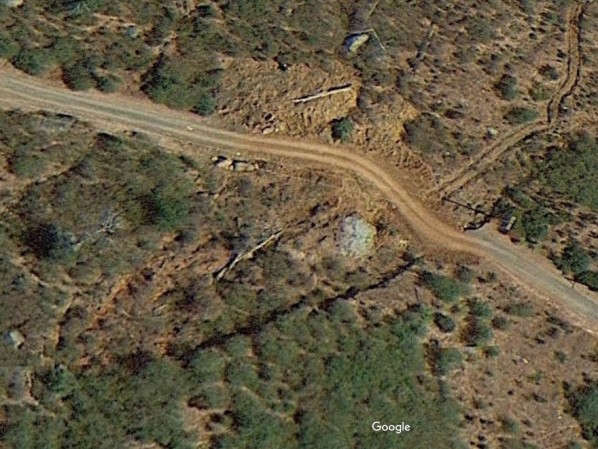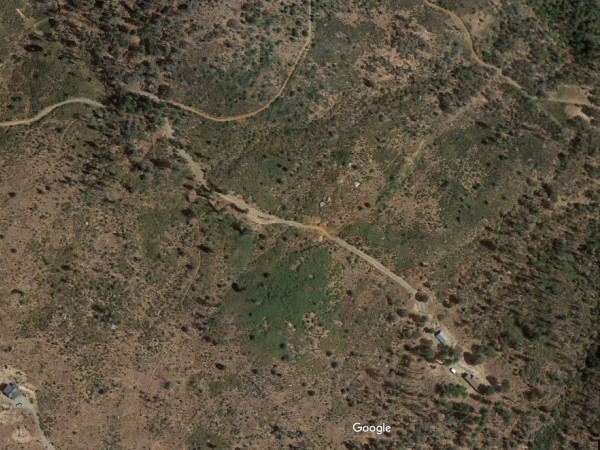
2017 Landslide
Living with Mother Nature
If we choose to live where we can enjoy her beauty, we must also expect to tolerate her moods. And after four years of drought, Mother Nature was in the mood to rain in 2017. And rain she did—18 inches in the first week of January (closing Yosemite National Park) and nearly twice the normal amount for the season—causing a major landslide in our driveway. The picture below shows the slide completely crossing the driveway on January 12TH.

Fortunately, our neighbor was able to dig a path through the next day with his backhoe.

But we needed a bigger rig to build a retaining wall to stabilize the slide, so a few days later we hired a contractor with a 40,000-pound excavator. Note our Jeep Wrangler parked on the other side of the slide—just in case.

Unfortunately, the water had saturated the soil throughout the area and was starting to take its toll on the driveway itself, which began to fail on February 9TH. We got both vehicles safely to other side shortly after taking this picture.

The very next day, on Friday February 10TH, an 80-foot stretch of our driveway failed completely. After taking this picture, I drove to the Verizon store to get us mobile phones because the underground cable for our landline phone and data service, which was buried in the driveway, was also destined to fail. That day and night, we got seven inches of rain.

Hoping to have at least some access restored, the excavator returned two days later. As expected, the ground was too wet to support vehicles, so we instead created a path for hiking across the abyss. Here the operator is removing one of the trees that fell during the 2008 Telegraph Fire. There were also Ponderosa pine stumps left over from the salvage logging—some three feet in diameter—in the debris.

The slide continued to move, so the excavator returned once again on March 1ST to spread the sloppy clay soil around, enabling it to dry faster. Here's the rig getting stuck in the muck at a 45° angle. Note both of our vehicles in the background. Our path through the area at this stage was a trail cut through the brush above the double-car-garage-size boulder to the right.

On May 1ST our contractor returned
yet again, this time with a smaller
excavator (weighing in at a "mere" 12,000 pounds), to create a temporary, drivable
path through the slide on the uphill side.
The temporary path was cut into the
hillside, which is mostly loam
and not the sloppy clay that had caused the driveway to slide.
The rainy season had ended, but as a precaution we installed two temporary culverts
(one shown being carried in here) just in case Mother Nature's uncharacteristic "wet and wild" mood returned.
Here's Leonard driving through the
temporary (and very bumpy) driveway for the first time in nearly three
months, during which time we had to put on our boots and hike the quarter-mile
from the house carrying in groceries and taking out the trash. What great
exercise!
Here's a shot from Google Earth showing
the slide area after the repair was made. The slide begins in the lower
left; the tracks heading to the upper right are from when the big excavator
needed to exit the area downhill after getting stuck in the muck.
And here's a shot, also from Google
Earth, showing where the slide occurred along our driveway--far from the house!
On October 16TH, nine months after the
slide began, the soil had dried out sufficiently for the big excavator to return—hopefully
for the last time—to permanently restore the slumped hill and driveway.
Here's the excavator about 150 feet up
the hill at the top of the slide where the heavy rains had caused a new underground
spring to form.
And here's a shot from the top of the slide.
To get the proper moisture content we
needed a water truck to soak the drier soil. Note the 25,000-pound compactor
also arriving in the background.
Here's the excavator creating "lifts" of soil for the compactor to
pack into "terra firma" for stability.
With the road surface in drivable
shape, work could begin building the rock retaining wall.
Here's one of the larger rocks (boulders,
really) being placed. Note how its weight is causing the excavator to
tip.
And here's a boulder too big to lift,
so it's getting held up by the bucket while being pushed into place instead.
These operators are remarkably skillful, capable of making their machines handle
tasks that appear to be impossible.
After completing the retaining wall,
work began on the ditches and culverts. Here's one of two 30-foot long 12-inch culverts being installed in the "new" driveway.
Work began next shoring up the area
downhill from the driveway to assure adequate support and drainage. And yes,
that's El Capitan in Yosemite Valley center-right near the horizon.
The final step involved grading and
gravel, and for that we needed a road grader, shown here turning around at the house.
Note the dead pine trees in the background, killed by the region's bark beetle
infestation.
Here's the grader "crowning" the
driveway so that water flows to either side. Water flowing into the ditch (on
the left) from both the driveway and the uphill side of the slide is carried to the downhill side by the
two culverts, the opening for one of which is visible center-left.
And finally, here is one of three loads of slate
being spread on the "new" driveway. Slate creates an impermeable surface that
will keep rain and melting snow from saturating the soil underneath.
The worst part of this ordeal
(notwithstanding the cost!) was living for nearly three months knowing that an
ambulance would not be able to reach the house in a medical emergency. Thank you
Mother Nature for sparing us that ordeal. Return to the
RedBuck Retreat Main Page 

















